

Machine Learning for Humans. Supervised Learning [SB Kotsiantis] AI Horizon: Introduction to Machine Learning. Machine Learning, Part I: Supervised and Unsupervised Learning (Up to General AI) Machine Learning, Part II: Supervised and Unsupervised Learning Last time, we discussed two types of learning that were based on the result of learning.
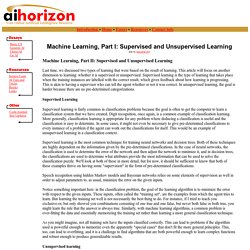
This article will focus on another dimension to learning: whether it is supervised or unsupervised. Supervised learning is the type of learning that takes place when the training instances are labelled with the correct result, which gives feedback about how learning is progressing. This is akin to having a supervisor who can tell the agent whether or not it was correct. Supervised Learning Supervised learning is fairly common in classification problems because the goal is often to get the computer to learn a classification system that we have created. Supervised learning is the most common technique for training neural networks and decision trees.
As you might imagine, not all training sets have the inputs classified correctly. Machine Learning Yearning - deeplearning.ai. Bernhard Schölkopf - Max Planck Institute for Biological Cybernetics, Max Planck Institute. Bernhard Schölkopf's scientific interests are in the field of machine learning and perception.
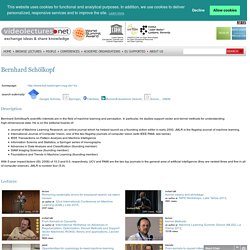
In particular, he studies support vector and kernel methods for understanding high-dimensional data. He is on the editorial boards of: Journal of Machine Learning Research, an online journal which he helped launch as a founding action editor in early 2000. JMLR is the flagship journal of machine learning. International Journal of Computer Vision, one of the two flagship journals of computer vision (with IEEE PAMI, see below) IEEE Transactions on Pattern Analysis and Machine Intelligence Information Science and Statistics, a Springer series of monographs Advances in Data Analysis and Classification (founding member) SIAM Imaging Sciences (founding member) Foundations and Trends in Machine Learning (founding member) Bernhard Schölkopf's scientific interests are in the field of machine learning and perception.
Education. Neural networks and deep learning. Free AI Resources. Machine Learning for Free. Deep Learning básico con Keras (Parte 1) El aprendizaje supervisado está ampliamente usado para el entrenamiento en sistemas de visión.
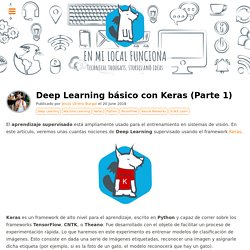
En este artículo, veremos unas cuantas nociones de Deep Learning supervisado usando el framework Keras. Keras es un framework de alto nivel para el aprendizaje, escrito en Python y capaz de correr sobre los frameworks TensorFlow, CNTK, o Theano. Fue desarrollado con el objeto de facilitar un proceso de experimentación rápida. Lo que haremos en este experimento es entrenar modelos de clasificación de imágenes. Esto consiste en dada una serie de imágenes etiquetadas, reconocer una imagen y asignarle dicha etiqueta (por ejemplo, si es la foto de un gato, el modelo reconocerá que hay un gato). En este primer artículo entrenaremos una red neuronal sencilla y, a partir de éste, iremos viendo unos cuantos algoritmos conocidos de deep learning y haremos unas cuantas comparativas. Enlace al artículo original.
Importando las librerías necesarias En primer lugar, vamos a importar las librerías necesarias. Neural Networks from Scratch with Python Code and Math in Detail— I. Towardsdatascience. Develop Your First Neural Network in Python With Keras Step-By-Step. Last Updated on September 15, 2020 Keras is a powerful and easy-to-use free open source Python library for developing and evaluating deep learning models.
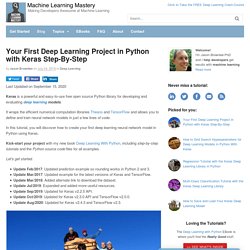
It wraps the efficient numerical computation libraries Theano and TensorFlow and allows you to define and train neural network models in just a few lines of code. In this tutorial, you will discover how to create your first deep learning neural network model in Python using Keras. Kick-start your project with my new book Deep Learning With Python, including step-by-step tutorials and the Python source code files for all examples. Let’s get started. Develop Your First Neural Network in Python With Keras Step-By-StepPhoto by Phil Whitehouse, some rights reserved. Keras Tutorial Overview There is not a lot of code required, but we are going to step over it slowly so that you will know how to create your own models in the future. The steps you are going to cover in this tutorial are as follows: This Keras tutorial has a few requirements: 1. 2. 3.
Machine Learning with Python: Neural Networks Introduction. Tema2 PerceptronAdalineRN. Revuelta Briz Ruben. Redes neuronales desde cero (I) - Introducción - IArtificial.net. En este primer post de una serie de tres, hablaremos de una de las ramas más importantes del Machine Learning y la Inteligencia Artificial, las redes neuronales.
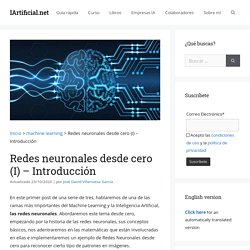
Abordaremos este tema desde cero, empezando por la historia de las redes neuronales, sus conceptos básicos, nos adentraremos en las matemáticas que están involucradas en ellas e implementaremos un ejemplo de Redes Neuronales desde cero para reconocer cierto tipo de patrones en imágenes. Introducción Las redes neuronales (neural networks) se enmarcan dentro del campo de la Inteligencia Artificial. En primer lugar, decir que hace unos 25 años prácticamente nadie sabía lo que era Internet ni su significado, como podéis comprobar en este vídeo del programa Today Show de 1994.
Las redes neuronales se inventaron en los años 60, ¿qué ha ocurrido entonces? Un poco de historia En 1994, los ordenadores tenían una capacidad muy limitada . Machine learning archivos - IArtificial.net.